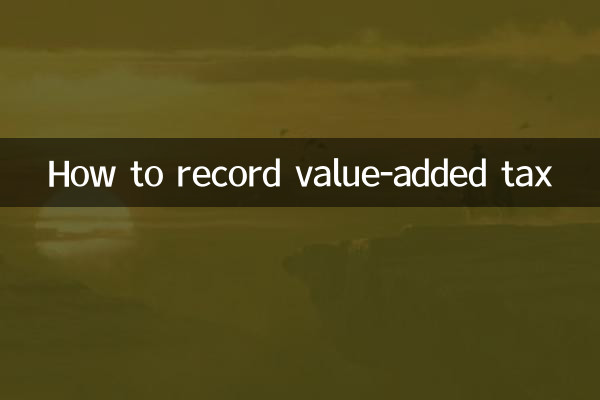How to record value-added tax
Value-added tax, as an important tax in my country's tax system, is crucial to corporate financial management. Correct VAT accounting not only ensures tax compliance but also optimizes business cash flow. This article will combine the hot finance and tax topics on the Internet in the past 10 days, analyze the VAT accounting method in detail, and provide structured data examples.
1. Basic principles of VAT accounting

Value-added tax is an extra-price tax and a "deduction system" is implemented. Taxpayers need to record the output tax and input tax separately, and ultimately pay the difference. Accounting points include:
| subjects | Debit | lender |
|---|---|---|
| Procurement business | Raw materials/inventory items Taxes payable - VAT payable (input tax) | Accounts payable |
| Sales business | Accounts receivable | Main business income Taxes payable - VAT payable (output tax) |
2. Accounting processing of different types of business
1.General taxpayerTypical business processing:
| Business type | accounting entries |
|---|---|
| Purchase raw materials | Borrow: raw materials Taxes payable - Value-added tax payable (input tax) Loan: bank deposit |
| selling goods | Debit: accounts receivable Credit: Main business income Taxes payable - Value-added tax payable (output tax) |
| Pay VAT | Debit: Taxes payable - VAT unpaid Loan: bank deposit |
2.small taxpayerSimplified processing:
| Business type | accounting entries |
|---|---|
| Procurement business | Borrow: raw materials Loan: bank deposit |
| Sales business | Debit: accounts receivable Credit: Main business income Taxes payable - VAT payable |
3. VAT treatment of special business
Recent fiscal and tax hot topics show that the following special businesses require special attention:
| special business | Key points to deal with |
|---|---|
| Cross-border e-commerce | 0 tax rate or tax exemption policy applies and needs to be accounted for separately |
| Excess tax refund | It needs to be calculated through the account of "Tax Payable-VAT Excess Credit" |
| Simple tax calculation items | Input tax cannot be deducted and must be accounted for separately |
4. Month-end carry forward process of VAT
1. Calculate the VAT payable this month:
Value-added tax payable = output tax – input tax – tax credit left over from the previous period
2. Carry forward entries:
| steps | accounting entries |
|---|---|
| Output tax carried forward | Debit: Taxes payable - Value-added tax payable (output tax) Credit: Taxes payable - VAT payable (unpaid VAT transferred out) |
| Carry forward input tax | Debit: Taxes payable - VAT payable (unpaid VAT transferred out) Credit: Taxes payable - Value-added tax payable (input tax) |
| Confirm tax payable | Debit: Taxes payable - VAT payable (unpaid VAT transferred out) Credit: Taxes payable - VAT not paid |
5. Frequently Asked Questions
Q: What should I do if the special VAT invoice is lost?
A: It must be reported to the tax authorities in writing on the day the loss is discovered, and the deduction can be certified with a copy of the accounting slip provided by the seller.
Q: How to record inter-period invoices?
A: Corporate income tax is handled on an accrual basis, and value-added tax must be declared in the current period when the invoice is issued.
Q: How to keep accounts for tax-free business?
A: Debit: accounts receivable; credit: main business income. If the output tax is not confirmed, the corresponding input tax needs to be transferred out.
6. Latest policy concerns
According to recent fiscal and tax hot topics, special attention needs to be paid to:
1. VAT preferential treatment for small and micro enterprises will be extended to 2027
2. Changes in accounting processing after the comprehensive promotion of digital invoices
3. VAT treatment in the super deduction policy for R&D expenses
Correct accounting of VAT can not only reduce tax risks, but also help enterprises plan their tax burdens reasonably. It is recommended that enterprises regularly participate in tax training, update their financial and tax knowledge in a timely manner, and consult professional tax consultants when necessary.

check the details

check the details